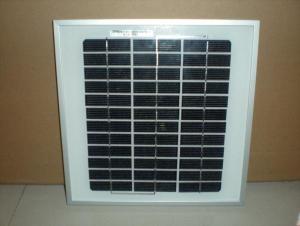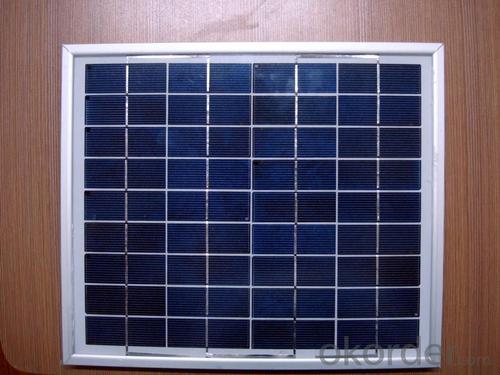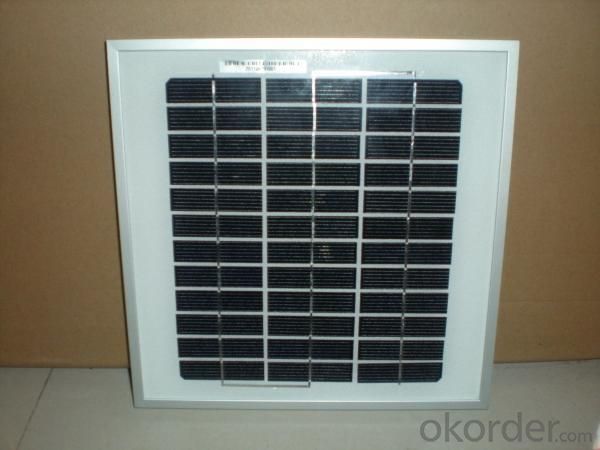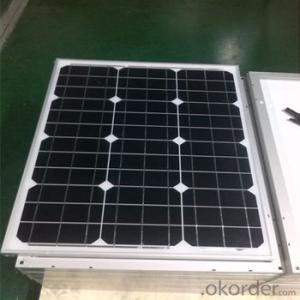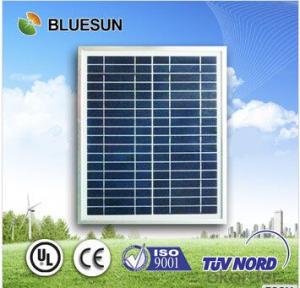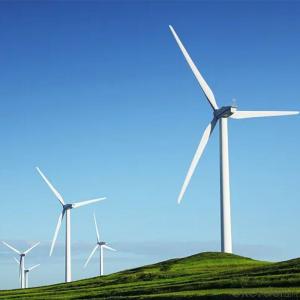Solar Polycrystalline Solar Panels Set
- Loading Port:
- Shanghai
- Payment Terms:
- TT
- Min Order Qty:
- 1 pc
- Supply Capability:
- 100000/month pc/month
OKorder Service Pledge
OKorder Financial Service
You Might Also Like
Solar Polycrystalline Series
Introduction of Solar Polycrystalline Series
CNBM Solar photovoltaic (PV)module is designed for large electrical power requirements. It is the optimal choice for both on-grid and off-grid power systems. CNBM Solar panel offers high performance of power per square foot of solar array.Poly- or multicrystalline silicon(poly-Si or mc-Si): made from cast square ingots — large blocks of molten silicon carefully cooled and solidified. Poly-Si cells are less expensive to produce than single crystal silicon cells, but are less efficient. US DOE data shows that there were a higher number of multicrystalline sales than monocrystalline silicon sales.
Characteristics of Solar Polycrystalline Series
I.Solar Cell : High efficiency crystalline solar cell. Even if under the weak light, the solar module can produce maximum power output.
II.Tempered glass (toughened glass): Anti-reflecting coating and high transmission rate glass increase the power output and mechanical strength of solar module.
III.EVA and TPT: Using high quality EVA and TPT to prevent destroying and water.
IVAI frame: Without screw, corner connection. 6 holes on the frame can be installed easily.
V.Junction box: Multi function junction box with water proof.
VI.Long lifetime: ≥25 years; Less power decrease.
VII,Good performance of preventing from atrocious weather such as wind and hails.
VIII.Resisting moisture and etching effectively, not effected by geology. .
Standard Test Conditions of Solar Polycrystalline Series
The opto-electrical specifications shown below are stabilized values being measured at Standard Test Conditions of multicrystalline silicon Solar Panel, Irradiance: 1000W/m2, Spectrum: AM1.5 at 25°C, The info below is subject to manufacturing tolerances. Where appropriate minutes of measurement are available and are used for the dimensioning of the installation.
Advantages of Solar Polycrystalline Series
• CNBM Solar performance guarantees for 25 years
• 2 years guarantee for workmanship for multicrystalline silicon Solar Panel
• Timeliness of delivery
CNBM International Corporation's products including Monocrystalline Solar Panel, Polycrystalline Solar Panel ( multicrystalline silicon Solar Panel) have received and enjoyed famous reputation in many countries and regions in the world .As a solar panel manufacturer in China, we strive to provide our customers with excellent service, superior products and unmatched value.
Characteristics of Solar Polycrystalline Series
Max Power Voltage Vmp (V) | 9.5V | 9.6V | 17.2V |
Max Power Current Imp (A) | 0.32A | 0.52A | 0.58A |
Open Circuit Voltage Voc (V) | 12.0V | 12.1V | 21.8V |
Short Circuit Current Isc (A) | 0.35A | 0.58A | 0.65A |
Max Power Pm (W) | 3W | 5W | 10W |
Temperature Coefficient of Cells
NOCT | 47℃±2℃ |
Temperature Coefficients of Isc (%/℃) | 0.064 |
Temperature Coefficients of Voc (%/℃) | -0.33 |
Temperature Coefficients of Pmp (%/℃) | -0.45 |
Mechanical Data of Solar Polycrystalline Series
Power | 3W | 5W | 10W |
Dimension | 250×180×18mm | 250×250×18mm | 350×290×18mm |
Weight | 0.8kg | 0.9kg | 1.3kg |
Tolerance | ±3% | ±3% | ±3% |
The dimension of the modules can be changed according to the demand of clients
Limits of Solar Polycrystalline Series
Operating Temperature | –40 °C to +85°C |
Storage Temperature | –40 °C to +85°C |
Max System Voltage | 700V |
Guarantee of Solar Polycrystalline Series
Products Guarantee | 2 yrs free from defects in materials and workmanship |
Performance Guarantee | No less than 90% within 10yrs and no less than 80% within 20yrs |
Certificates | IEC, ISO, TUV, CE |
The Package of Solar Polycrystalline Series
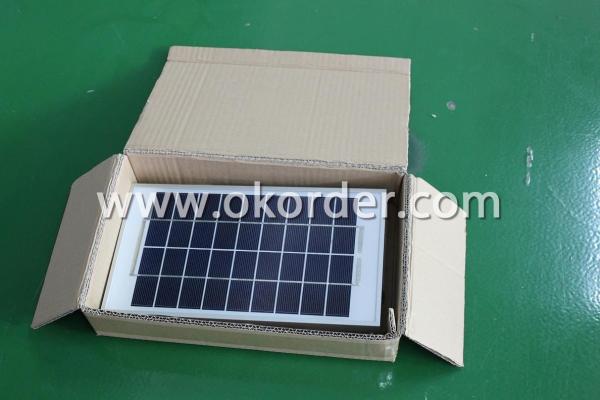
The Usage of Solar Polycrystalline Series
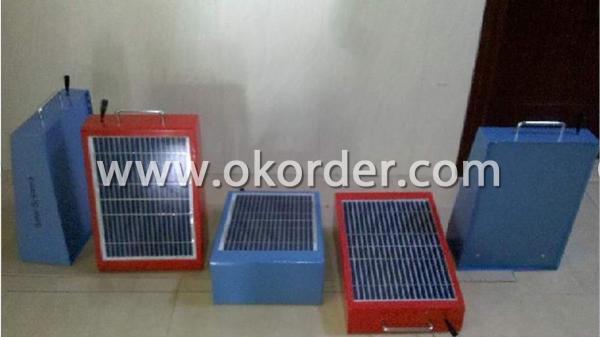
The Production Equipment of Solar Polycrystalline Series
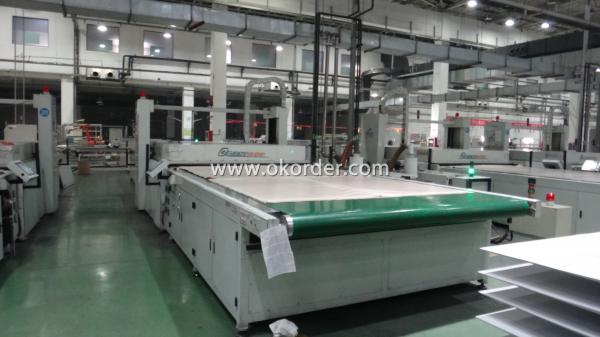
- Q:What do I need to use this as a battery charger
- I hope this will help you choose your charge controller / battery charger more effectively. Good luck!
- Q:i was looking into making solar panels to reduce my electric bill, but i need to know how to actually hook it up.
- nowing what to do with unused renewable electricity is always a dilemma – hooking up to the grid has to be the preferred option. If your residential home is grid tied, i.e. connected the electricity grid as opposed to off-grid and you are using solar panels to generate electricity. Then it makes a lot of sense to hook your solar panels to the grid, because instead of losing the unused electricity or having to maintain a bank of deep cycle batteries, you simply feed it back to the grid. You feed electricity back to the grid via your electric meter which measures the electricity in Kilowatt per hour. This has the effect of reversing your meter which in turn reduces your electricity bills and if you are generating a lot of electricity you could find the utility company owing you money! The Solar Powered System Therefore, your solar powered installation would look like this. The solar panel will connect to an “array disconnect” – you need an array disconnect for system maintenance because it allows you to easily shut off the power. The array disconnect is connected to an “inverter”. The solar panel generates DC power and the electricity from the grid is AC power. Therefore, you need an inverter to convert DC power to AC power. The inverter is connected to an “AC breaker panel”. This is the interface where your solar generated electricity meets the electric meter and allows you to feed electricity back to the grid. Now in most countries and states you are not allowed to tamper with the electric meter so at this point you should contact your local electricity energy supplier and ask them to supply an engineer to hook you up to the grid. If you have anything to add to this article or you have connected your system to the grid – tell us how you did it by writing a comment below.
- Q:Could you throw some long scientific words in with your answer so I can impress my teacher, I'm looking to expand my scientific vocab. Thanks
- Actually Photovoltaic cells also called solar cells in collection forms solar panel. Photovoltaic cells consist of silicon for converting solar energy into electrical energy.
- Q:I have created a solar setup in my shed i have 2x.5w solar panels i am hoping to charge my 55ah car battery how long would it take to charge the battery and how many watts could i used a day
- To charge a 2V lead acid battery, you pretty much have to put almost 24V across it and it's only 50% efficient at charging so if your solar panel does put out 3W, you can expect 3/24/2 or /6th of an amp in usable charging. Therefore, from a flat battery, it would take 55*6 or 880 hours to charge the battery. If you assume about 6 hours of usable sunlight per day, that would be 47 days not taking into consideration the normal leakage that lead acid batteries have. It's quite likely that the leakage rate will be greater than the charging rate and the battery will never charge. You'll need a bigger solar panel.
- Q:Just curious.
- Since you said does instead of do I think it would be fruitless trying to explain it...
- Q:I am designing a solar panel but i need to have maximum power output.How can i optimize the equation for power Total power=voltage * current to get maximum power.
- first place the panel so it is at right angles to the solar rays. Make sure none of the panel has any shade whatsoever. For best results use motor drives to keep it in that position as the sun moves across the sky. For overall maximum versus time, you need to be near the equator. Solar cells have a high internal resistance, so for maximum power transfer, you need a load of that same resistance. A good charge controller will use DC-DC converters to provide that load. .
- Q:I would love to put in solar panels on my roof, but how hard would it be, and how expensive? Would I be able to do the work myself, or would I have to hire a pro?Also I live in Oregon, so much of the time it is overcast, so would it really be worth it?
- Not a good idea. The reason why panels are that much more expensive than cells is that the panels themselves are not that cheap either. If you start with the cells, you'll need - mechanical protection (hail, ice, snow) - electrical protection (i.e. waterproofing - if water comes in contact with the cells and wires, you'll get electrolysis which will corrode your wires and contacts faster than you can say 'b*mmer') - that setup will need to withstand temperatures between -20 and +30 °C (only guessing, might be worse) - oh, and the side facing the sun must be transparent (as far as possible) Now as to connecting the stuff: no, it will be neither easy to connect it to the house power nor to the grid - which is why that step (at least) in all countries I know of must be done by a certified electrician. If you get it wrong and you're lucky, only _your_ inverter will explode. Regarding the power: these 4W per cell (or kW for your shed) is the peak value, i.e. with the sun shining orthogonally onto the cells on a clear day. Since this (for a fixed installation) will only be true (at most) for a few minutes on a few days each year, your overall yield will be significantly less, probably more like 4 kWh/day for each clear day for each kWpeak you install _IF_ the shed roof is oriented exactly south and inclined towards the sun's noon position at the spring/autumn equinox (i.e. inclination angle = your geographical latitude). How many clear days do you have in britain? Yes, I had a similar idea for myself - but for one thing, the registered companies I addressed apparently weren't really interested in that small fry, plus the cost of the system + setup would barely have been amortized after the expected lifetime, even taking into account the (german) governmental subsidies. If I had the money to spare, I'd rather invest in a communal solar park. Much better ROI, the large installations get much better prices (per kW) for the setup.
- Q:Can solar panels be installed on bridges or highways?
- Yes, solar panels can be installed on bridges or highways. In fact, many countries have started implementing solar panels on such structures to harness solar energy and generate electricity. This integration of renewable energy technology with infrastructure not only helps produce clean energy but also optimizes space utilization and promotes sustainability.
- Q:Is it possible for a 2V rated panel to charge a bank of batteries equal to around 36V? I believe that the panels should equal or exceed the voltage of the batteries but, I'm not for certain.
- you'll have to use 3 panels connected in series or use a dc to dc up converter, the former is a better option
- Q:What is the principle of solar panels to convert solar energy into electricity?
- scientists have applied solar cells to space technology - communication satellites. At the end of the last century, in the process of human self-reflection, this clean and direct energy form for photovoltaic power generation has become more cordial, Not only in space applications, in many areas also show their talents. Such as: solar garden lights, solar power generation system, the village power supply independent system, photovoltaic pumps (drinking water or irrigation), communication power, oil pipeline cathodic protection,
1. Manufacturer Overview |
|
|---|---|
| Location | Jiangsu, China |
| Year Established | 2004 |
| Annual Output Value | Below US$1 Million |
| Main Markets | Australia;Asia;South East Asia; South America;North America; Europe;Africa |
| Company Certifications | ISO 9001:2008; CE; TUV; UL |
2. Manufacturer Certificates |
|
|---|---|
| a) Certification Name | |
| Range | |
| Reference | |
| Validity Period | |
3. Manufacturer Capability |
|
|---|---|
| a)Trade Capacity | |
| Nearest Port | Shanghai |
| Export Percentage | 1% - 10% |
| No.of Employees in Trade Department | 200-300 People |
| Language Spoken: | English;Chinese |
| b)Factory Information | |
| Factory Size: | Above 8,000 Square meter |
| No. of Production Lines | 6 |
| Contract Manufacturing | OEM Service Offered;Design Service Offered |
| Product Price Range | Average |
Send your message to us
Solar Polycrystalline Solar Panels Set
- Loading Port:
- Shanghai
- Payment Terms:
- TT
- Min Order Qty:
- 1 pc
- Supply Capability:
- 100000/month pc/month
Offcanvas right
OKorder Service Pledge
OKorder Financial Service
Similar products
New products
Hot products
Hot Searches
Related keywords

